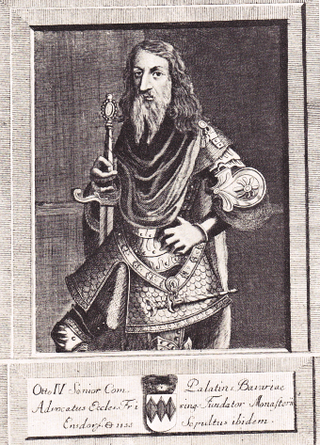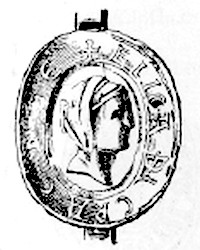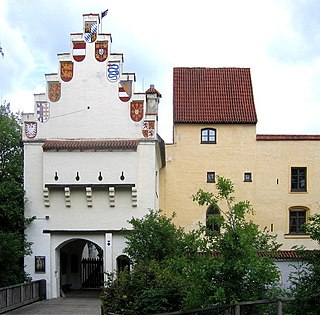
The House of Wittelsbach is a former Bavarian dynasty, with branches that have ruled over territories including the Electorate of Bavaria, the Electoral Palatinate, the Electorate of Cologne, Holland, Zeeland, Sweden, Denmark, Norway, Hungary, Bohemia, and Greece. Their ancestral lands of Bavaria and the Palatinate were prince-electorates, and the family had three of its members elected emperors and kings of the Holy Roman Empire. They ruled over the Kingdom of Bavaria which was created in 1805 and continued to exist until 1918.
A count palatine, also count of the palace or palsgrave, was originally an official attached to a royal or imperial palace or household and later a nobleman of a rank above that of an ordinary count. The title originated in the Late Roman Empire. In the Middle Ages especially and into modern times, it is associated with the Holy Roman Empire, especially Electoral Palatinate.
Aichach-Friedberg is a Landkreis (district) in Bavaria, Germany. It is bounded by the districts of Augsburg, Donau-Ries, Neuburg-Schrobenhausen, Pfaffenhofen, Dachau, Fürstenfeldbruck and Landsberg, as well as by the city of Augsburg.

Neuburg an der Donau is a town which is the capital of the Neuburg-Schrobenhausen district in the state of Bavaria in Germany.
Duke in Bavaria was a title used among others since 1506, when primogeniture was established, by all members of the House of Wittelsbach, with the exception of the Duke of Bavaria which began to be a unique position. So reads for instance the full title of the late 16th century's Charles I, Count Palatine of Zweibrücken-Birkenfeld and patriarch of the House of Palatinate-Birkenfeld: "Count Palatine by Rhine, Duke in Bavaria, Count to Veldenz and Sponheim". The title grew in importance as Wilhelm, Count Palatine of Zweibrücken-Birkenfeld-Gelnhausen began to use it, in the early 19th century, as his primary title – Duke Wilhelm in Bavaria. This choice has also had effect for his descendants.
Otto II, called the Illustrious, was the Duke of Bavaria from 1231 and Count Palatine of the Rhine from 1214. He was the son of Louis I and Ludmilla of Bohemia and a member of the Wittelsbach dynasty.
Louis I, called the Kelheimer or of Kelheim, since he was born and died at Kelheim, was the Duke of Bavaria from 1183 and Count Palatine of the Rhine from 1214. He was the only surviving son of Otto I, Duke of Bavaria by his wife Agnes of Loon. He married Ludmilla of Bohemia, a daughter of Duke Frederick of Bohemia.
Otto I, called the Redhead, was Duke of Bavaria from 1180 until his death. He was also called Otto VI as Count Palatine of Bavaria from 1156 to 1180. He was the first Bavarian ruler from the House of Wittelsbach, a dynasty which reigned until the abdication of King Ludwig III of Bavaria in the German Revolution of 1918.
Fischbachau Priory was a Benedictine monastery located in Fischbachau, Bavaria, Germany.

Scheyern Abbey, formerly also Scheyern Priory, is a house of the Benedictine Order in Scheyern in Bavaria.

Palatinate-Neuburg was a territory of the Holy Roman Empire, founded in 1505 by a branch of the House of Wittelsbach. Its capital was Neuburg an der Donau. Its area was about 2,750 km2, with a population of some 100,000.

Otto V, Count of Wittelsbach, also called Otto IV, Count of Scheyern, was the second son of Eckhard I, Count of Scheyern and Richardis of Carniola and Istria. Otto named himself Otto of Wittelsbach, after Wittelsbach Castle near Aichach. He served Henry V, Holy Roman Emperor, in his first Italian Expedition in 1110–1111. Emperor Henry V already addressed him as Otto Count of "Witlinesbac" in a document in 1115. From 1120 onwards, he was Count palatine of Bavaria.

Elisabeth of Bavaria was Queen of Germany and Jerusalem from 1246 to 1254 by her marriage to King Conrad IV of Germany.

The coat of arms of Bavaria has greater and lesser versions.

Princess Elisabeth Marie of Bavaria was a member of the Bavarian Royal House of Wittelsbach.

Agnes of the Palatinate (1201–1267) was a daughter of Henry V, Count Palatine of the Rhine, of the House of Welf, by his first wife Agnes of Hohenstaufen, daughter and heiress of Conrad of Hohenstaufen, Count Palatine of the Rhine. She married Otto II Wittelsbach, Duke of Bavaria.

Heilika of Pettendorf-Lengenfeld was by marriage Countess Palatine of Bavaria.
Eckhard I of Scheyern, also Ekkehard von Scheyern, was a son of Otto I, Count of Scheyern. His mother cannot be unambiguously determined because Otto I Scheyern was first married to Haziga of Diessen and later to an unknown daughter of Count Meginhardt of Reichersbeuern, and the date of Eckhard's birth is not known.

Grünwald Castle is a medieval hill castle in Grünwald, Bavaria.














